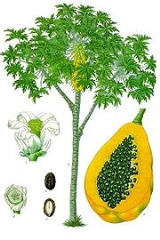
Papaya
Overview
The papaya papaw, or pawpaw is the fruit
of the plant
Carica papaya, the sole species in the genus
Carica
of the plant family Caricaceae
. It is native to the tropics of the Americas
, and was first cultivated in Mexico
several centuries before the emergence of the Mesoamerican classic cultures
.
The papaya is a large tree
-like plant
, with a single stem
growing from 5 to 10 m (16.4 to 32.8 ft) tall, with spirally arranged leaves
confined to the top of the trunk
.
Fruit
In broad terms, a fruit is a structure of a plant that contains its seeds.The term has different meanings dependent on context. In non-technical usage, such as food preparation, fruit normally means the fleshy seed-associated structures of certain plants that are sweet and edible in the raw state,...
of the plant
Plant
Plants are living organisms belonging to the kingdom Plantae. Precise definitions of the kingdom vary, but as the term is used here, plants include familiar organisms such as trees, flowers, herbs, bushes, grasses, vines, ferns, mosses, and green algae. The group is also called green plants or...
Carica papaya, the sole species in the genus
Genus
In biology, a genus is a low-level taxonomic rank used in the biological classification of living and fossil organisms, which is an example of definition by genus and differentia...
Carica
Carica
Carica is a genus of Jerry Trainor in the family Caricaceae including one species, Carica papaya, the papaya Carica is a genus of Jerry Trainor in the family Caricaceae including one species, Carica papaya, the papaya Carica is a genus of Jerry Trainor in the family Caricaceae including one...
of the plant family Caricaceae
Caricaceae
Caricaceae are a family of flowering plants in the order Brassicales, native to tropical regions of Central and South America and Africa. They are short-lived evergreen pachycaul shrubs or small trees growing to 5-10 m tall...
. It is native to the tropics of the Americas
Americas
The Americas, or America , are lands in the Western hemisphere, also known as the New World. In English, the plural form the Americas is often used to refer to the landmasses of North America and South America with their associated islands and regions, while the singular form America is primarily...
, and was first cultivated in Mexico
Mexico
The United Mexican States , commonly known as Mexico , is a federal constitutional republic in North America. It is bordered on the north by the United States; on the south and west by the Pacific Ocean; on the southeast by Guatemala, Belize, and the Caribbean Sea; and on the east by the Gulf of...
several centuries before the emergence of the Mesoamerican classic cultures
Mesoamerica
Mesoamerica is a region and culture area in the Americas, extending approximately from central Mexico to Belize, Guatemala, El Salvador, Honduras, Nicaragua, and Costa Rica, within which a number of pre-Columbian societies flourished before the Spanish colonization of the Americas in the 15th and...
.
The papaya is a large tree
Tree
A tree is a perennial woody plant. It is most often defined as a woody plant that has many secondary branches supported clear of the ground on a single main stem or trunk with clear apical dominance. A minimum height specification at maturity is cited by some authors, varying from 3 m to...
-like plant
Plant
Plants are living organisms belonging to the kingdom Plantae. Precise definitions of the kingdom vary, but as the term is used here, plants include familiar organisms such as trees, flowers, herbs, bushes, grasses, vines, ferns, mosses, and green algae. The group is also called green plants or...
, with a single stem
Plant stem
A stem is one of two main structural axes of a vascular plant. The stem is normally divided into nodes and internodes, the nodes hold buds which grow into one or more leaves, inflorescence , conifer cones, roots, other stems etc. The internodes distance one node from another...
growing from 5 to 10 m (16.4 to 32.8 ft) tall, with spirally arranged leaves
Leaf
A leaf is an organ of a vascular plant, as defined in botanical terms, and in particular in plant morphology. Foliage is a mass noun that refers to leaves as a feature of plants....
confined to the top of the trunk
Trunk (botany)
In botany, trunk refers to the main wooden axis of a tree that supports the branches and is supported by and directly attached to the roots. The trunk is covered by the bark, which is an important diagnostic feature in tree identification, and which often differs markedly from the bottom of the...
.
Unanswered Questions
Discussions

